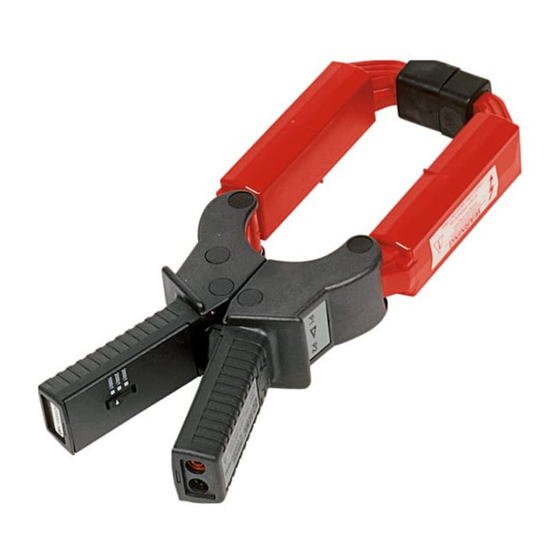
Advertisement
Quick Links
AC Current Probe
Model JM865A
User Manual
DESCRIPTION
The JM865A (Catalog #2110.88) is designed for use in industrial environments. The
"squared" jaws permit multiple conductor or bus bar positioning. The current output makes
it the perfect tool for measurement with DMMs, recorders, power and harmonic meters.
Three ranges allow you to obtain the best resolution even on low current measurement.
The JM865A is compatible with any AC ammeter, multimeter, or other current measuring
instrument with an input impedance lower than 2 Ω. To achieve the stated accuracy, use the
JM865A with an ammeter with an accuracy of 0.75 % or better.
WARNING
These safety warnings are provided to ensure the safety of personnel and proper operation
of this instrument.
■
Read this instruction manual completely and follow all safety information before
attempting to use or service this instrument
■
Use caution on any circuit; potentially high voltages and currents may be present and
may pose a shock hazard
■
Read the Safety Specifications section prior to using the current probe. Never exceed
the maximum voltage ratings given
■
Safety is the responsibility of the operator
■
ALWAYS connect the current probe to the display device before clamping the probe
onto the sample being tested
■
ALWAYS inspect the instrument, probe, probe cable, and output terminals prior to use.
Replace any defective parts immediately
■
NEVER use the current probe on electrical conductors rated above 600 V in
overvoltage category III (CAT III). Use extreme caution when clamping around bare
conductors or bus bars
INTERNATIONAL ELECTRICAL SYMBOLS
This symbol signifies that the current probe is protected by double or reinforced
insulation. Use only factory-specified replacement parts when servicing the instrument.
This symbol signifies CAUTION! The user must refer to the user manual before using
the instrument.
This symbol signifies that this is a type A current sensor and that application near and
removal from HAZARDOUS LIVE conductors is permitted.
DEFINITION OF MEASUREMENT CATEGORIES
CAT IV: For measurements performed at the primary electrical supply (<1000 V), such as
primary overcurrent protection devices, ripple control units, or meters.
CAT III: For measurements performed in the building installation at the distribution level,
such as hardwired equipment in fixed installation or circuit breakers.
CAT II: For measurements performed on circuits directly connected to the electrical
distribution system, such as household appliances or portable tools.
RECEIVING YOUR SHIPMENT:
Upon receiving your shipment, make sure that the contents are consistent with the packing
list. Notify your distributor of any missing items. If the equipment appears to be damaged,
file a claim immediately with the carrier and notify your distributor at once with a detailed
description of any damage.
Advertisement

Summary of Contents for AEMC instruments JM865A
- Page 1 Three ranges allow you to obtain the best resolution even on low current measurement. The JM865A is compatible with any AC ammeter, multimeter, or other current measuring instrument with an input impedance lower than 2 Ω. To achieve the stated accuracy, use the JM865A with an ammeter with an accuracy of 0.75 % or better.
- Page 2 CURRENT PROBE - JM865A DRAWING Ø=2.52" (64 mm) Cable max. 1.97 x 5.31" (50 x 135 mm) or 2.52 x 3.94" (64 x 100 mm) Bus Bar max. 12.40" (315 mm) 1.89" (48 mm) 4.72" (120 mm) Black ELECTRICAL SPECIFICATIONS Load Impedance: ≤0.4 Ω...
- Page 3 OPERATION Please ensure that you have read and fully understand the WARNING section on page 1. Making Measurements with the AC Current Probe Model JM865A ■ Connect the black and red terminals to the Ampere AC range of your DMM or current measuring instrument.
- Page 4 Tips for Making Precise Measurements ■ When using a current probe with a meter, it is important to select the range that provides the best resolution. Failure to do this may result in measurement errors. ■ Make sure that probe jaw mating surfaces are free of dust and contamination. Contaminants cause air gaps between the jaws, increasing the phase shift between primary and secondary.













Need help?
Do you have a question about the JM865A and is the answer not in the manual?
Questions and answers